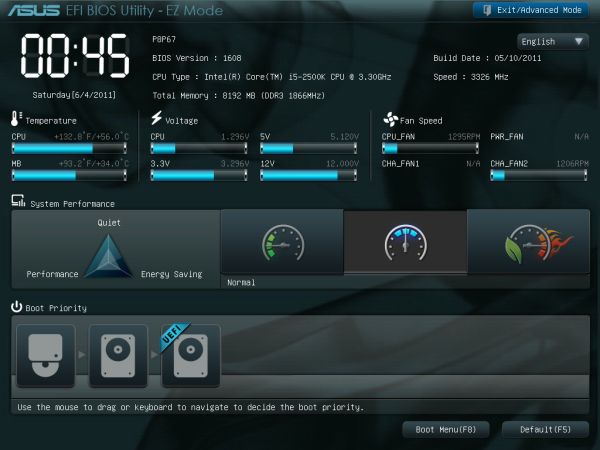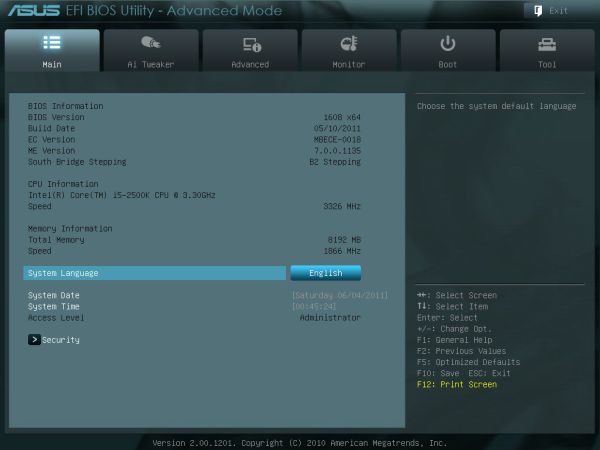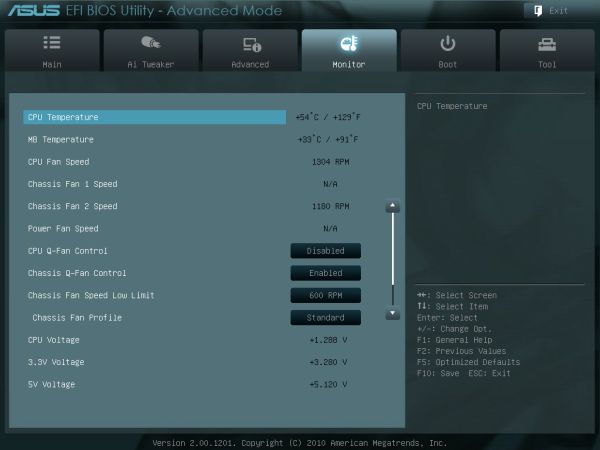ASUS P8P67 Review
by Brendan van Varik on September 8, 2011 10:45 AM EST- Posted in
- Asus
- Motherboards
- P67
BIOS
When you enter the BIOS for the very first time, you’ll be faced with the screen below. If you want to do any serious tweaking, you will have to enter the Advanced Mode, which you can do by clicking on the button located in the top right-hand corner.
At a quick glance, the basic BIOS layout shows more or less everything you need. It shows the CPU and motherboard temperatures, the voltages, fan settings with the current fan speeds and the boot sequence, which is switchable.
You can update the BIOS with relative ease with a USB flash drive. You will need to be in Windows in order to download the BIOS from ASUS’ website and to extract the .ROM file. It my experience, my 8GB stick was not detected, which is most likely a compatibility issue. However I did have a 4GB flash drive which did work in flashing to the latest BIOS.
The BIOS features a full UEFI system and it is easy to use. Everything is located where you would expect it to be and I can only find two issues with the BIOS. During this review, I used the 1608 BIOS which does not report CPU temperatures correctly. I also experienced that selecting the ‘OC Tuner’ option in the BIOS made the motherboard lock itself into an infinite boot cycle which would not disappear without a full CMOS reset.
After I did my testing, I updated the BIOS to the 1808 release which appears to have solved the CPU temperature issue.
As you can see from the screenshot above, there are not very options to change your fan settings. Just like in the ASUS Suite (noted in the software section of this review), you can choose from a few presets to change the fan speeds or you can manually assign some of your own.
Overclocking
As the ASUS Suite software allows gives us an option to ‘Auto Tune’ our PC from within Windows, I figured I would start out there. The 'Fast' pre-set was tested, giving a 31% overclock. It has increased the BCLK to 103 and the multiplier is set at 42. The RAM also got a boost up to 1866MHz by using X.M.P profiling.
After an hour at full load under OCCT, CPU-Z reported a maximum voltage of 1.296v when under load – my previous tests revealed that this particular CPU needed between 1.32 and 1.34v (set in the BIOS with high Load Line Calibration/‘LLC’) to be completely stable. The minimum voltage went down to 1.27v which could be tweaked a little with different LLC settings.
Considering how the software had taken care of the overclock, I was eager to try out the ‘Extreme’ preset. Sadly the results were not as impressive - the system attempted to raise the BCLK from 103MHz which it was set at from the ‘Fast’ pre-set to 103.5MHz. The system fell over and produced a blue screen. Once the system had restarted itself, it attempted to raise the BCLK to 103.5MHz again. It failed for a second time and on the third restart it left me with the same overclock as I originally had on the 'Fast' pre-set.
Using a maximum voltage of 1.42 V (1.75 V PLL) on the CPU, I was able to successfully boot up at 46x103 which gave me a final clock speed of 4738MHz. The system was nowhere near stable but it would get into Windows and run a few tests before crashing. By lowering the BCLK to 100 and increasing the multiplier to 47, I was able to get it stable enough to run all of our benchmarks. It was extremely easy to reach a 4700MHz clock speed. It was a case of finding the right voltage to match the given CPU frequency.
So, I removed the ‘safe’ voltage boundary and boosted the multiplier to see how far this board would really go. Just so that there was some extra headroom, the voltages got a slight increase, 1.5v on the core and the PLL voltage got a slight bump up to the original 1.8v. Windows would not boot at 5GHz, or 4.9GHz for that matter. At 48x100, Windows booted up straight away but when I tried to push the system past 101.5 BCLK, it would instantly result in a blue screen of death.
I decided to opt for a CPU voltage of 1.42 V and a PLL voltage of 1.75 V to do the rest of my testing with this motherboard. I wanted to demonstrate what sort of an effect overclocking has and what the benefits to it really are. In this instance, I ran our 3D Movement benchmark. I only ran the benchmark once to give you a rough idea of the performance gains. At stock speeds with turbo disabled, the overall score came in at 104.32 for the single threaded benchmark and 331.88 for the multi-threaded version. For a 29.7% overclock, there was a 27.8% increase (104.32 to 144.87) in performance using the single threaded application and a 30% (331.88 to 474.27) increase in the multi-threaded benchmark.



















52 Comments
View All Comments
Blaster1618 - Thursday, September 8, 2011 - link
I am so tired of LGA-1155 being portrayed as an "Enthusiast Board"-Dual-channel memory.
-Narrow PCI Bus.
-Virtually fixed core clock.
-and the stake to the heart....on board graphics.
Wait...wait LGA-2011 and i7 3-series will spice up the M-board review business.
zero2dash - Thursday, September 8, 2011 - link
Troll much?Onboard graphics has no performance penalty on a 2600K (let alone a 2500K) so throw that piss poor reason out the window.
Narrow PCI bus? Yes, because that's clearly dragging SB systems through the mud. So is the dual channel memory.
Fixed core clock? Who gives a crap? Yeah, because a locked core clock with an unlocked multiplier is a worse option than an unlocked core clock and a limited amount of multiplier options.
Have fun paying for those quad channel ram kits.
A5 - Thursday, September 8, 2011 - link
A) Memory bandwidth has very little discernible effect on non-benchmark applications. Modern CPUs are so good at cache management that there is almost 0 reason to chase memory bandwidth. Ironically, the 1156 CPUs probably need the bandwidth more (due to the onboard graphics) than the 2011 CPUs will.B) If you need more than two PCI-e x8 slots, then you're the kind of person who will drop the cash on LGA-2011 anyway. This is a legit knock against P67 and Z68, but it also only affects the hardcore enthusiasts, the top 1% of the top 1% who are running 3 or 4 GPUs.
C) LGA-2011 is going to have fixed clocks too. With multipliers unlocked, this is kind of a moot point anyway.
D) Considering P67 doesn't even allow you to use the onboard graphics, I don't see how this is a valid complaint.
I think P67 is a perfectly acceptable "enthusiast" product, and honestly I'd be surprised if there is an LGA-2011 version of Ivy Bridge outside of the server space.
RussianSensation - Thursday, September 8, 2011 - link
You should leave him alone :)He is probably going to future-proof his LGA-2011 setup with 32GB (4x8GB) for $1200:
http://www.newegg.com/Product/Product.aspx?Item=N8...
....because 32GBs in Quad-Channel LGA2011 Pawwwwwwwns all!
Blaster1618 - Saturday, September 10, 2011 - link
Not Hating... but I figured as soon as the Z series board was out, the H&P series boards would drop, rightfully so, in the bargain bin.I obvious to me that the 2nd generation i7 have an internal memory architecture limitation. (ie they were not designed for enthusiasts) Cut and paste old North Bridge architecture on the die. The bandwidth(bitwidth) of the internal communication 3rd generation chips is nearly twice the 2nd generation and it has 20 Gbit DMI 2.0.
If you don't believe bandwidth matters, I have a bin full old 64 bit Geforce cards for sale. I play games on my X-box, My computers for Solid modeling and Finite element analysis and surfing pron.
I was under the understanding the issues with the base clock adjust-ability were issues with the on board GPU's sensitivity to frequency. I am hoping the base clock on the I7 3820 will have 30-40% overclock like the LGA1366 or my old E6600.
At <$300 the i7 3820 should be quite a deal ps my business picks up the $1,200 for the 32 GB of Corsair XMS.
RussianSensation - Thursday, September 8, 2011 - link
2500k - $220This board - $135
vs. i7-990X
http://www.xbitlabs.com/articles/cpu/display/core-...
Care to explain how a $355 mobo+cpu setup trades blows with an overclocked $999 i7 CPU on "enthusiast" LGA1366?
I hope you enjoy your $300 LGA2011 Motherboard + $500-1000 CPU for 1 quarter until IVB launches and obsoletes LGA2011 for anyone but workstation users.
Etern205 - Friday, September 9, 2011 - link
pfff....Yep, have fun waiting for that Ivy Bridge of yours....
http://vr-zone.com/articles/the-upgrade-path-to-iv...
CharonPDX - Thursday, September 8, 2011 - link
If you've used any Intel Desktop Board in the past three years, you've used a UEFI-based configuration utility. It's just one designed to look like an old fashioned 'BIOS' screen. (P.S., technically it hasn't been a "BIOS" in a while, it's been a configuration utility.)Concillian - Thursday, September 8, 2011 - link
So why is the P8P67 consuming 20 more watts at idle than the P8P67 Pro in it's review?Shouldn't the less featured board be using less power?
Mumrik - Thursday, September 8, 2011 - link
I looked around for a relatively cheap motherboard with 8+ SATA ports for a 2500k and this board was by far the cheapest. Reading up in forums (especially at the [H] where Asus is active) and at Newegg I got the impression that there was an unusual amount of problems with the generation of Asus boards, so I chickened out and picked up an Asrock instead.